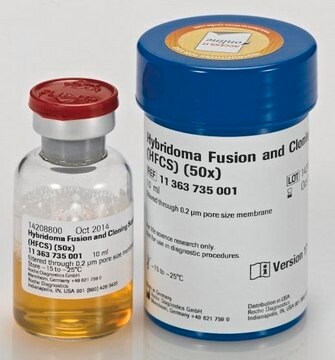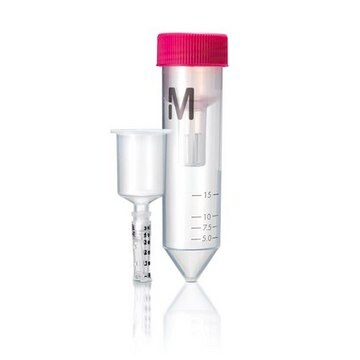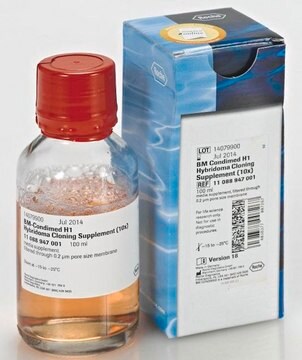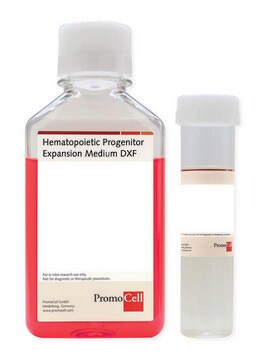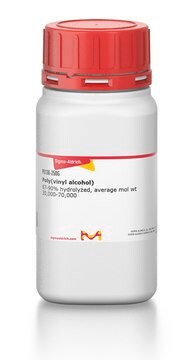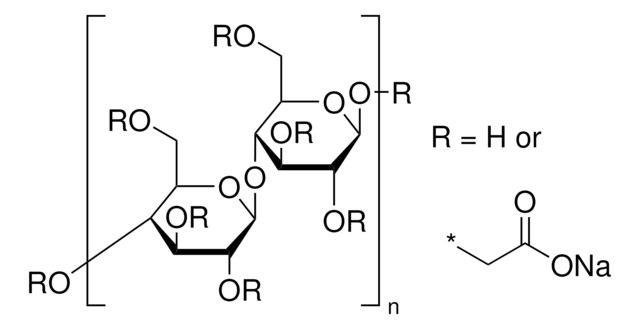11011375001
Roche
Nutridoma™-SP
suitable for hybridoma, solution, pkg of 100 mL (100x)
Synonym(s):
hybridoma, nutridoma
Sign Into View Organizational & Contract Pricing
All Photos(1)
About This Item
UNSPSC Code:
12352207
Recommended Products
sterility
sterile; 0.2 μm filtered
Quality Level
form
solution
packaging
pkg of 100 mL (100x)
manufacturer/tradename
Roche
concentration
100 ×
technique(s)
cell culture | hybridoma: suitable
impurities
mycoplasma, tested
≤100 EU/mL Endotoxin (LAL test)
solubility
water: miscible
storage temp.
20-25°C
Related Categories
General description
Nutridoma is a family of chemically defined supplements that can completely replace serum in cell culture media. Nutridoma-SP is used for the cultivation of established myeloma and hybridoma cells. It is used for the serum-free cultivation of murine myelomas and hybridomas that have an intact cholesterol biosynthesis pathway, such as those derived from the SP2/0, and some of the P3x63Ag8.653 cell lines and lymphoblastoid cell lines, as well as for primary lymphoid cell cultures. It is also used for the serum-free culture of a variety of other cell types, including neural explants.
Application
Nutridoma-SP has been used in the culture media for canine trophoblasts, human embryonic stem cells and PLB-985 cells.
Unit Definition
Endotoxin (LAL): 10 EU/ml; mycoplasma-tested
Physical form
Solution, 100x concentrated, filtered through 0.2 μm pore size membrane
Biochemically defined serum-free medium supplement composed of albumin, insulin, transferrin, and other defined organic and inorganic compounds. Nutridoma contains no other growth factors, mitogens, hormones, or sterols.
The solution contains the pH indicator phenol red and appears clear.
Biochemically defined serum-free medium supplement composed of albumin, insulin, transferrin, and other defined organic and inorganic compounds. Nutridoma contains no other growth factors, mitogens, hormones, or sterols.
The solution contains the pH indicator phenol red and appears clear.
Preparation Note
Working concentration: Nutridoma-SP (100x) is diluted 1:100 (v/v) with sterile basal medium. Use high glucose DMEM/RPMI 1640 (1:1) (R/D medium) for Nutridoma-SP. The final medium should also contain L-glutamine and sodium bicarbonate. The protein concentration is less than 50 μg/ml for 1% working concentration.
Storage conditions (working solution): 2 to 8 °C
Nutridoma working solutions, e.g., media containing 1% Nutridoma (1%) are stable for 4 weeks when stored at 2 to 8 °C in the dark. Do not freeze.
Note: Do not store in plastic as adsorption of ingredients to the plastic surface may occur.
Storage conditions (working solution): 2 to 8 °C
Nutridoma working solutions, e.g., media containing 1% Nutridoma (1%) are stable for 4 weeks when stored at 2 to 8 °C in the dark. Do not freeze.
Note: Do not store in plastic as adsorption of ingredients to the plastic surface may occur.
Other Notes
For life science research only. Not for use in diagnostic procedures.
Legal Information
Nutridoma is a trademark of Roche
Storage Class
12 - Non Combustible Liquids
wgk_germany
nwg
flash_point_f
No data available
flash_point_c
No data available
Choose from one of the most recent versions:
Already Own This Product?
Find documentation for the products that you have recently purchased in the Document Library.
Customers Also Viewed
L Sahlfeld et al.
Reproduction in domestic animals = Zuchthygiene, 47 Suppl 6, 161-164 (2013-01-04)
Shallow trophoblast invasion is detrimental in human pregnancies, but represents normal endotheliochorial placentation in dogs. Factors regulating shallow trophoblast invasion into the canine decidua are not well described, but it is known that matrix metalloproteinases (MMPs) play a crucial role
Abderrahman Chargui et al.
PloS one, 7(12), e51727-e51727 (2012-12-29)
Invading bacteria are recognized, captured and killed by a specialized form of autophagy, called xenophagy. Recently, defects in xenophagy in Crohn's disease (CD) have been implicated in the pathogenesis of human chronic inflammatory diseases of uncertain etiology of the gastrointestinal
Adeleye Opejin et al.
Cell reports, 33(8), 108424-108424 (2020-11-26)
Various processes induce and maintain immune tolerance, but effector T cells still arise under minimal perturbations of homeostasis through unclear mechanisms. We report that, contrary to the model postulating primarily tolerogenic mechanisms initiated under homeostatic conditions, effector programming is an integral
Kristín Rós Kjartansdóttir et al.
PloS one, 10(12), e0144029-e0144029 (2015-12-03)
Human embryonic stem cell differentiation towards various cell types belonging to ecto-, endo- and mesodermal cell lineages has been demonstrated, with high efficiency rates using standardized differentiation protocols. However, germ cell differentiation from human embryonic stem cells has been very
Our team of scientists has experience in all areas of research including Life Science, Material Science, Chemical Synthesis, Chromatography, Analytical and many others.
Contact Technical Service